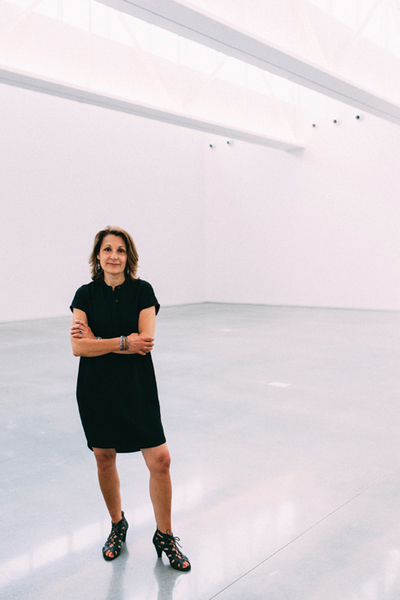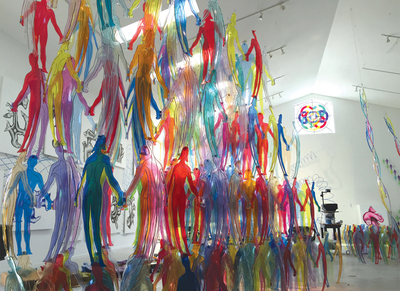Reborn In Rockland

Digital rendering of the CMCA exterior.
Long-awaited and anticipated, the Center for Maine Contemporary Art (CMCA) has opened the doors of its new state-of-the-art building—its sawtooth roofline proudly cresting the skyline of Rockland. Designed by internationally acclaimed architect Toshiko Mori, the 11,000-square-foot building’s innovative exterior is made of reflective glass, stainless steel and zinc. Its striking presence enhances the small city’s reputation as one of Maine’s top year-round arts destinations, elevating it to a new level of urbanity and sophistication.
“It was designed around the concept of turning the traditional museum inside out. Instead of an imposing formal facade, the new Center for Maine Contemporary Art is completely transparent. The glass-walled central courtyard invites visitors into the museum space before they even enter the building, merging the museum and the community,” says Suzette McAvoy, the center’s executive director.
The building beautifully captures Maine’s famous natural light—a draw for artists for centuries—by allowing diffused northern illumination through the main gallery’s high clerestory windows. “The light is uniformly cool, even, and direct; and natural light requires less artificial light, reducing our use of electricity,” says McAvoy. “The three exhibition galleries are contiguous, so we can do one, two, or three shows at a time, and the galleries vary in size and ceiling height, allowing us to handle a wide range of work in different media.”
The inaugural exhibitions showcase the museum’s flexibility. The more than 2500-square-foot main gallery houses the site-specific installation, Human Structures, by internationally acclaimed sculptor Jonathan Borofsky. Brightly colored, overlapping, translucent figures float in the gallery’s airy space. An accompanying 24-foot figurative sculpture by the artist greets visitors as they enter the center’s courtyard.
Small Paintings in the adjacent Bruce Brown Gallery features intimate works by the legendary painter Alex Katz, showing rarely seen small-scale oils created by the artist as the start of larger pieces.
The CMCA’s third gallery houses Vernal Pool—provocative portraits and images of the human figure—by Portland and Los Angeles-based photographer and video artist Rollin Leonard.

Executive director Suzette McAvoy. Photo: Jonathan Laurence.
“By creating this exciting, larger platform to showcase contemporary art, my hope is that the new CMCA will bring greater awareness to the important role the arts play in Maine, both within the state and beyond,” says McAvoy.
And says New-York-based painter Katherine Bradford who also has a studio in Brunswick: “This new building and location will make a great difference to those of us who depend on Maine for a home as well as a place to thrive and practice art, raising the bar for each and every artist, whether a visitor or exhibitor at the CMCA.”
The organization’s early life in Rockport was vibrant, begun by a group of volunteers as Maine Coast Artists cooperative in 1952. In 1967, a former firehouse and stable was purchased, and this building became its home until 2015. Since the beginning, the organization’s mission has been to show current work by Maine artists, and consequently the organization renamed itself the Center for Maine Contemporary Art in 2002.
But eventually, the center outgrew its out-of-the-way location, and its relocation to Rockland didn’t happen easily. Without the move, the center could have died financially due to lack of visibility, and these factors forced the board of directors to let go of its staff and consider closing during the winter of 2009. In the interim, they consulted with McAvoy concerning the dire situation, and subsequently hired her as director in September of 2010. McAvoy’s background as chief curator at the Farnsworth Museum between 1988 and 2006, along with additional experience in the museum field over the course of 30 years, prepared her for the challenging road that lay ahead.
“When I started at CMCA, the organization was on financial life support, and it truly was an open question of whether it could survive. But it was actually the crisis that set our move and renaissance into motion. It was a ‘do or die’ moment; we had to take the risk and do something bold,” McAvoy recalls. Her vision and determination, along with that of her board, staff, and a fleet of volunteers, have taken the center from bankruptcy to rebirth.

Gallery view rendering.
The addition of the CMCA to Rockland with its focus on Maine’s art-of-the-moment, complements the venerated Farnsworth Art Museum and Wyeth Center, completing an overview of traditional and contemporary Maine work.
“That the CMCA has opened its new building this summer is nothing short of a miracle. The opening of a $5 million project in an ideal location within a three-minute walk of the Farnsworth Museum in the center of downtown Rockland still seems unbelievable. Now visitors can experience the long and distinguished history of Maine art from its earliest days at the Farnsworth to the art of tomorrow at the CMCA, practically within a stone’s throw of one another. No other city in Maine can claim the same experience,” says Bruce Brown, who served as the center’s curator from 1987 until 2006.
The need to move the center from Rockport to Rockland had been recognized for years. An opportunity to acquire a building in Rockland came up many years prior, but the timing was wrong, and it remained in Rockport. When the Rockland property at 21 Winter Street came up for sale in 2013, McAvoy and her board knew they couldn’t hesitate to seize this prime location. They purchased it and began a capital campaign under the leadership of Marilyn Moss Rockefeller who had previously chaired fundraising for renovations of the Rockport building. Over the course of almost six years, the center has raised over $5 million and will continue to seek much-needed funding to sustain the building, staff, and programs that the center provide.

Jonathan Borofsky, Human Structures, site-specific installation. All images courtesy of CMCA.
One of its most significant programs is ArtLab, which was established in 2011. This educational outreach program has attracted thousands of participants of all ages, carrying out its mission of “inspiring the creative process through adventurous thinking, as individuals and families discover, interact, and invent.” And with the latest technology in the galleries and online, the CMCA will also be able
to offer programs to audiences beyond its physical walls.
“There are always challenges in making a big institutional change, and in raising a significant amount of money, but having a very clear vision and an extremely supportive board and staff kept us all working together toward the same goal. It’s remarkable what can be achieved together if you really believe in the value of the mission,” says McAvoy. This constant affirmative approach to McAvoy’s leadership, along with her board’s determination, saw the project through the process of fundraising and building. Even in moments of difficult and tiring uncertainty, they stayed flexible to what could be done in the moment to continue moving forward, resulting in what may have seemed to some to be an impossible goal.
The arts community of Rockland is excited about the move of the CMCA to their growing community. “There is an optimism and positive momentum in our community. The CMCA’s focus on contemporary art is a welcome addition, filling a niche that helps to place art in real time, at the edge of what is current and happening today,” says Bruce Busko, owner of the Landing Gallery which represents Maine and New England artists.
“It is a move that will continue to energize artists and allow CMCA to put down deeper roots in the community, and at the same time, reach larger audiences in New England and New York,” says Dudley Zopp, a painter/installation artist who lives in nearby Lincolnville.
Over the course of many years, the CMCA has contributed to the continuing legacy of Maine artists by showing greats such as Robert Indiana, Lois Dodd, Jamie Wyeth and Neil Welliver, to name a few.
With this move, the continuation of the institution’s long lineage is now assured, as it boldly reflects, through its architecture and holdings, the pluralism of Maine’s 21st-century art landscape. Painter Lois Dodd, whose influence on the arts in Maine has been felt for decades, states it concisely: “The CMCA is clearly now the magnet and showplace for the best and most innovative art in the state.”
Katherine Duncan Aimone is a painter and arts writer who owns ArtsWrite—a company that provides essays for artists.
SIDEBAR
Center for Maine Contemporary Art
Rockland, ME
cmcanow.org
Rollin Leonard: Vernal Pond
On view through August 14, 2016
Alex Katz: Small Paintings
On view through August 17, 2016
Jonathan Borofsky: Human Structures
On view through August 21, 2016
